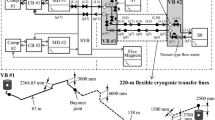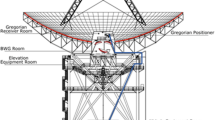Abstract
A proper cryogenic environment is essential for the operation of superconducting devices. A test area for the superconducting radio-frequency modules (SRF) has been established in the RF laboratory at National Synchrotron Radiation Research Center in Taiwan; these modules require much liquid helium during conditioning and performance tests; a cooling capacity of 120 W is expected for the acceptance test of the SRF module. The cryogenic environment of the test area is completed on transferring the liquid helium over a remarkable length of 205 m from the two cryogenic plants at Taiwan Light Source, with a valve box located at each end to control and to measure the cryogenic flow. Flexible cryogenic transfer lines of concentric four-tube type are chosen for both the supply of liquid helium and the return of cold helium gas. Functional examination of this long transfer system was first achieved with a 500-L Dewar in the radio-frequency laboratory; an SRF module was then installed in the test area for practical operation. The primary concern about the cryogenic transfer system is the heat loss; a measurement technique based on the principle of thermodynamics is developed and proposed herein. With the available sensors inside the valve boxes and the heaters inside the 500-L Dewar and the test SRF module, this technique has proved promissing from the measured results.
Similar content being viewed by others
1 Introduction
The National Synchrotron Radiation Research Center is constructing a 3-GeV synchrotron facility, the Taiwan Photon Source (TPS) [1]. To build the radio-frequency (RF) system for this TPS project, an RF test area has been established in the RF laboratory. A cryogenic environment is essential for the superconducting radio-frequency (SRF) module, which requires much liquid helium during conditioning and performance tests. A cooling capacity 120 W is expected for the acceptance test of the selected SRF modules.
The two liquid-helium plants in the experimental area of the Taiwan Light Source (TLS) have a total capacity of 900 W [2], much beyond the operating requirements of the SRF module and superconducting magnets in the TLS. The valve box for the SRF module of the TLS, located near the liquid-helium plants and referred as VB #1 hereafter, has one complete set of spare ports to serve as source ports for the cryogenic transfer system. To cope with the complicated piping route of 205-m length from VB #1 to the RF laboratory and the limited working period in radiation-restricted areas, CRYOFLEX® [3] flexible transfer lines of concentric four-tube type were selected. Impressively, the installation of these two long transfer lines required only five days [4]. Both cryogenic transfer lines were then connected to VB #1 at one end, with vacuum-jacketed flexible lines of 5-m length, and connected to another valve box in the RF laboratory, to be referred as VB #2 hereafter, at the other end, with vacuum-jacketed flexible lines of 2-m length. A 500-L liquid-helium Dewar, and a phase separator for liquid nitrogen were linked to one set of the extraction port of VB #2 with vacuum-jacketed flexible lines of 8-m length. Numerous preparation tasks, including leak testing, system purging, wiring, integration with a control and monitoring system, interlock and safety checks, were then undertaken carefully [4].
This long cryogenic transfer system would benefit not only the test and development of SRF modules but also those of the superconducting magnets. As the primary concern, the heat load on each long cryogenic transfer line was the next to be measured. A measurement technique based on thermodynamics has thus been developed and proposed. With a 500-W heater built inside, the 500-L Dewar was used to measure the heat load with promising results. Then a spare SRF module was also attached to VB #2 through another set of extraction ports by other vacuum-jacketed flexible lines of 8-m length. A heater was also equipped inside the test SRF module but capable of only 200 W, for which the same measurement technique was applied.
Some thermal properties of the liquid and gaseous helium are required for the measurement technique. The commercial software HEPAK [5] was used to determine the helium properties for the parameter calculations. Presented in this paper are the theoretical formulas deduced for the practical measurements of the heat loads along the transfer lines, and the test results.
2 Measurement of the Heat Load
2.1 Liquid Helium Transfer Line
When the pure saturated liquid at mass flow rate \(\dot{m}_{\mathrm{in}}\) flows through a cryogenic transfer system, the static heat load along all the path, \(\dot{q}_{\mathrm{TL}}\), vaporizes the liquid and thus delivers mixed liquid and gas to the vessel at the end of the transfer system. The static heat load of the end vessel \(\dot{q}_{V}\) and the applied heater power \(\dot{q}_{H}\) also generate gas. The total mass flow rate \(\dot{m}_{\mathrm{in}}\) is a sum of the gas flow \(\dot{m}_{G}\) and the liquid flow \(\dot{m}_{L}\) as
The pressure of the end vessel is certainly less than that of the supply source; some liquid vaporizes because of this pressure difference, known as the flash loss. For the case of the flash loss only, i.e., no heat load considered, the law of conservation of energy leads to
in which h Li is the enthalpy of the supplied liquid; h GV and h LV are the enthalpies of the gas and liquid at the end vessel, respectively. From Eqs. (1) and (2), the mass flow rate of the gas due to the flash loss is obtained as
in which S denotes the flash ratio of gas to supplied liquid.
For a practical measurement, only the special case of a constant level and a constant pressure in the end vessel is considered. Hence all delivered liquid is perfectly vaporized so that the end vessel maintains a constant liquid level, and all vaporized gas is expelled to maintain the end vessel at a constant pressure. The mass flow rate of the expelled gas equals exactly the supply flow rate \(\dot{m}_{\mathrm{in}}\). To simplify the analysis, all heat loads are equivalent so as to occur at the end vessel, which leads to
As a result, Eq. (1) is thus rewritten as
This equation leads to
The flow meter of Venturi type [6–8] built at the cold helium-gas return line of the valve box is used to measure the flow rate. The pressure difference ΔP across the Venturi meter is measured with a differential pressure transmitter and a process meter. The mass flow rate through a specified Venturi-type flow meter is proportional to the square root of the pressure difference [6, 8]. Equation (6) thus becomes modified to be related to the measured pressure difference as
in which C 1 is a Venturi-dependent coefficient. A practical form of Eq. (7) is
in which
Equation (8) is linear, and requires only the measured pressure difference through the Venturi meter at the varied applied heater power inside the end vessel, as the static heat losses \(\dot{q}_{\mathrm{TL}}\) and \(\dot{q}_{V}\) are constant, being characteristic of the transfer system and of the end vessel, respectively. The terms S and (h GV−h LV) in Eq. (9) are also constant as long as the conditions for liquid supply and the end vessel are decided. However, the heat loads on the liquid-helium transfer line and the end vessel cannot be separated with this measurement technique. An end vessel of known heat loss or of low heat loss, such as a Dewar, would thus benefit this measurement technique.
Illustrated in Fig. 1 are two measurements with the 500-L Dewar and the spare module installed as the end vessel, indicated as cases 3 and 7, respectively. From a linear fit of the measured data, the heat loads of these two cases are 61.55 W and 128.18 W, respectively. With the parameters (calculated with HEPAK) and the slopes of the linear fitted curves, the Venturi coefficient C 1 is obtained with Eq. (9). The operating conditions, main parameters and measured results are listed in Tables 1 and 2. For the case of the 500-L Dewar, on average the Venturi coefficient and the total heat load on liquid helium are 1.703 and 62.27 W, respectively, whereas they are 2.395 and 132.02 W for the case of the test SRF module. The cold helium gas in the two cases illustrated in Fig. 1 returns to VB #2 through two separate Venturi units; the calculated Venturi coefficients thus differ. The SRF module is expected to have a static heat loss 30 to 40 W greater than that of the Dewar. Moreover, the nominal diameter of the 8-m flexible line from VB #2 to the SRF module is 22 mm, much larger than the 10-mm diameter of the 500-L Dewar, mainly to decrease the pressure drop across this line. We thus conclude that the larger 8-m flexible transfer line contributes about 20 W more to the heat loss. This compromise will be examined, and this line might revert to an original 10-mm line if necessary.
Linear fits of data pairs are used to determine the heat loads on the liquid-helium transfer lines as indicated in Eq. (8), from applying varied heater power and measuring the pressure drop across the Venturi meter
The 10-m transfer path from the supply source to VB #1, three short vacuum-jacketed transfer lines, of total length of 16 m, three horizontal junctions with vacuum break, and two valve boxes along the 200-m helium transfer system all contribute to the heat loss. Based on the lower bound of the measured result of 62.27 W, the 200-m concentric four-tube line for liquid-helium transfer is estimated to have a heat loss less than 25 W, excellent for such a long cryogenic line with a nominal inner diameter of 21 mm.
2.2 Transfer Line for Gaseous Helium
When the pure gas at mass flow rate \(\dot{m}_{\mathrm{in}}\) flows through a transfer system, the static heat load along the path \(\dot{q}_{\mathrm{TG}}\) heats the gas to raise both its temperature and its enthalpy. The law of conservation of energy leads to
in which h G is the enthalpy of the gas at the measurement end point. The cryogenic linear temperature sensors (CLTS) at the valve boxes are unfortunately unable to provide an exact temperature to determine the enthalpy h G . According to operating experience, we assume that the exact gas temperature T G is the sum of the reading temperature T G,r and an offset δT G , as
Another corresponding simplification is to assume that the enthalpy change equals a product of the temperature rise and the equivalent specific heat with a correction factor κ as
in which T GV is the gas temperature of the end vessel; C PV is the specific heat of the saturated gas inside the end vessel. To determine an appropriate value for κ, an iterative process to minimize the error term
is applied for varied operating conditions of the end vessel and calculated gas temperature T G . Illustrated in Fig. 2 are variations of the error term with saturated pressure of 1.3 bar with κ 85 % and 75 %, and 1.25 bar with κ 75 % and 65 %, respectively. The temperatures for a perfect match for these four curves are 4.82, 5.31, 5.39 and 6.85 K, respectively. This figure shows that a larger κ should be chosen for a smaller temperature rise, either with a transfer line of lower heat loss or a greater flow rate of gas.
By defining
and with Eqs. (7), (10) and (11), Eq. (12) becomes
This equation is again linear: the measured data with varied applied heater power are thus used to obtain the slope and constant term—i.e. the static heat load and the temperature offset. The temperature of the end vessel, enthalpies of gas and liquid and specific heat are all calculated (with HEPAK) with the saturated pressure of the end vessel, as the flash ratio and heat load on the transfer line of liquid helium are already obtained in the preceding measurement.
This cryogenic transfer system has two valve boxes. The measured results for VB #2 determine the heat load on the 8-m vacuum-jacketed transfer line, referred to as \(\dot{q}_{\mathrm{TG}2}\), and the results for VB #1 determine the heat load along the entire path, including the 200-m concentric four-tube line, two valve boxes, and three short vacuum-jacketed lines, referred to as \((\dot{q}_{\mathrm{TG}1} + \dot{q}_{\mathrm{TG}2})\). After iterative processes to determine κ, reasonable values for the cases with the 500-L Dewar installed as the end vessel are 75 % for VB #2 and 65 % for VB #1, but 85 % and 75 %, respectively, for the case with the test SRF module installed. Illustrated in Fig. 3 are two measurements with the 500-L Dewar and the spare module installed as the end vessel, respectively, the same two cases illustrated in Fig. 1. From a linear fit of the measured data, the heat loads on the gas transfer lines and the temperature offsets at the measure points inside the valve boxes are obtained. All measured results are listed in Tables 1 and 2. First, the measured heat load along the long path of the gas transfer line, \(\dot{q}_{\mathrm{TG}1}\), has average values of 59.95 W and 52.95 W, respectively. Considering the contribution of the two valve boxes and the two short vacuum-jacketed flexible lines, the 200-m concentric four-tube line for the gaseous helium transfer should have a heat loss less than 40 W. This small heat loss is excellent for such a long cryogenic line with a large nominal inner diameter of 39 mm. The measured heat loss for the 8-m vacuum-jacketed flexible line from the 500-L Dewar to VB #2 is 42.90 W, indicating some fault on this line. The other one for the test SRF module has a smaller heat loss of 15.41 W on average; this value is reasonable for a 22-mm diameter line lacking liquid-nitrogen shielding.
Linear fits of measured data sets are used to determine the heat loads on the gas transfer lines from the end vessel to the valve boxes from applying Eq. (15)
Both temperature offsets on the cold helium-gas lines inside the valve boxes alter a little for the measurements. The measurements on the 500-L Dewar and on the test SRF module were separate for a long period, and the transfer system experienced some thermal cycles. Each calculated temperature offset presents a minute variation about the average value, because the CLTSs inside the valve boxes invariably shifted readings of a few K after a thermal cycle as usual.
3 Concluding Remarks
The proposed method provides a successful technique to measure the heat-load information for the long cryogenic transfer lines, especially solving the challenge of the gas line; the readings of the temperature sensors for the cold gas can be calibrated in the meantime. This measurement technique is thus promising, and will be adopted for the measurement of the current cryogenic transfer system and also of the future cryogenic system of TPS. The measured results prove also the excellent performance of the 200-m cryogenic transfer line of concentric-tube type. The small heat losses are of much benefit in the forthcoming tests on the superconducting devices. A long-term operation at a heater load of 120 W has been successfully tested as a practice on the coming acceptance test for the TPS SRF modules.
References
Kuo, C.C., et al.: In: Proc. of the 11th European Particle Accelerator Conference-EPAC08, Genoa, Italy, p. 1986 (2008)
Hsiao, F.Z., et al.: In: Proc. of the 11th European Particle Accelerator Conference-EPAC08, Genoa, Italy, p. 2503 (2008)
CRYOFLEX®: A commercial product of Nexans Deutschland GmbH, Hanover, Germany
Lin, M.C., et al.: In: Proc. of the 1st International Particle Accelerator Conference-IPAC10, Kyoto, Japan, 2010, p. 3843 (2010)
HEPAK: A commercial computer program CRYODATA, Inc., Louisville, Colorado, USA
Forster, M., Graber, J.: CESR SRF internal note (1996)
Belomestnykh, S., et al.: CESR SRF note, SRF-000202-03 (2000)
Lin, M.C., et al.: Adv. Cryog. Eng. 51, 1156 (2006)
Acknowledgement
National Science Council of Taiwan, Republic of China, provided partial support through grant NSC 100-2628-E-213-001-MY3.
Author information
Authors and Affiliations
Corresponding author
Rights and permissions
About this article
Cite this article
Lin, M.C., Wang, C., Chang, M.H. et al. Operational Characteristics of the 200-m Flexible Cryogenic Transfer System. J Supercond Nov Magn 26, 1479–1483 (2013). https://doi.org/10.1007/s10948-012-2035-x
Received:
Accepted:
Published:
Issue Date:
DOI: https://doi.org/10.1007/s10948-012-2035-x







